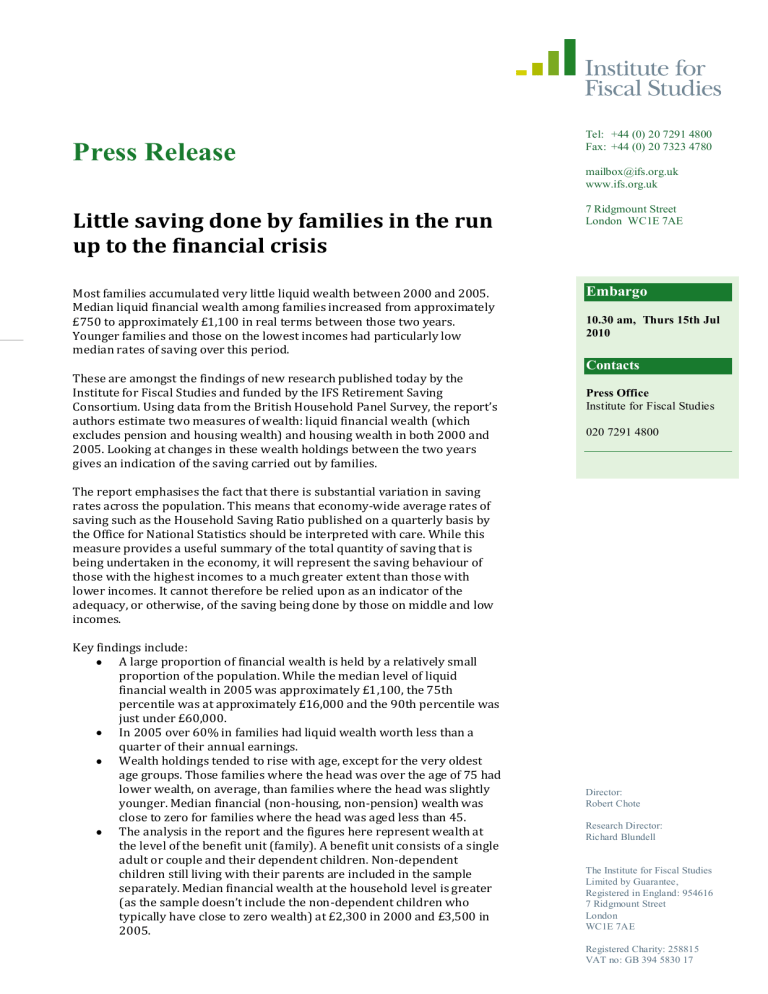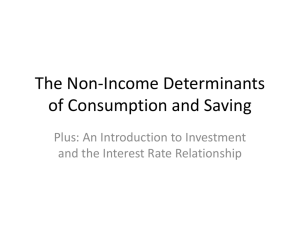Press Release

Press Release
Little saving done by families in the run up to the financial crisis
Most families accumulated very little liquid wealth between 2000 and 2005.
Median liquid financial wealth among families increased from approximately
£750 to approximately £1,100 in real terms between those two years.
Younger families and those on the lowest incomes had particularly low median rates of saving over this period.
These are amongst the findings of new research published today by the
Institute for Fiscal Studies and funded by the IFS Retirement Saving
Consortium. Using data from the British Household Panel Survey, the report’s authors estimate two measures of wealth: liquid financial wealth (which excludes pension and housing wealth) and housing wealth in both 2000 and
2005. Looking at changes in these wealth holdings between the two years gives an indication of the saving carried out by families.
The report emphasises the fact that there is substantial variation in saving rates across the population. This means that economy-wide average rates of saving such as the Household Saving Ratio published on a quarterly basis by the Office for National Statistics should be interpreted with care. While this measure provides a useful summary of the total quantity of saving that is being undertaken in the economy, it will represent the saving behaviour of those with the highest incomes to a much greater extent than those with lower incomes. It cannot therefore be relied upon as an indicator of the adequacy, or otherwise, of the saving being done by those on middle and low incomes.
Key findings include:
A large proportion of financial wealth is held by a relatively small proportion of the population. While the median level of liquid financial wealth in 2005 was approximately £1,100, the 75th percentile was at approximately £16,000 and the 90th percentile was just under £60,000.
In 2005 over 60% in families had liquid wealth worth less than a quarter of their annual earnings.
Wealth holdings tended to rise with age, except for the very oldest age groups. Those families where the head was over the age of 75 had lower wealth, on average, than families where the head was slightly younger. Median financial (non-housing, non-pension) wealth was close to zero for families where the head was aged less than 45.
The analysis in the report and the figures here represent wealth at the level of the benefit unit (family). A benefit unit consists of a single adult or couple and their dependent children. Non-dependent children still living with their parents are included in the sample separately. Median financial wealth at the household level is greater
(as the sample doesn’t include the non-dependent children who typically have close to zero wealth) at £2,300 in 2000 and £3,500 in
2005.
Tel: +44 (0) 20 7291 4800
Fax: +44 (0) 20 7323 4780 mailbox@ifs.org.uk www.ifs.org.uk
7 Ridgmount Street
London WC1E 7AE
Embargo
10.30 am, Thurs 15th Jul
2010
Contacts
Press Office
Institute for Fiscal Studies
020 7291 4800
Director:
Robert Chote
Research Director:
Richard Blundell
The Institute for Fiscal Studies
Limited by Guarantee,
Registered in England: 954616
7 Ridgmount Street
London
WC1E 7AE
Registered Charity: 258815
VAT no: GB 394 5830 17
Turning to rates of saving between 2000 and 2005, the authors find that:
There was substantial variation by age in the median rate of saving.
The highest rates of saving were to be found among those aged between 55 and 59 in 2000. When changes in the value of housing are not included, the median annual rate of saving for families in this age group between 2000 and 2005 was approximately 5% of their income. This compares to median saving rates that were slightly less than zero for those under the age of 25 and those over the age of 75 in 2000. Median annual saving rates for those in other age groups tended to be less than 1%, pension saving as substitutes – those who switch from paying into a pension to not saving into a pension tended to have substantially higher rates of saving compared to those who switch in the other direction.
For most families, the vast majority of wealth owned is held in illiquid forms.
While median liquid financial wealth in 2005 was close to £1,100, median housing wealth was over £60,000. The value of wealth held in pensions, both state and private, for most families, will be substantially greater than their holdings of liquid financial wealth.
“Many families, in particular the youngest families and those on the lowest incomes had very low rates of saving between 2000 and 2005” said Cormac
O’Dea, Research Economist at the Institute for Fiscal Studies and one of the report’s authors. “This period was one during which incomes grew substantially, but financial wealth, at least for most households, barely increased at all. For home-owners, increases in property prices between
2000 and 2005 led to large increases in wealth that tended to dwarf any active saving that they did.”
ENDS
For those families who own property, changes in the value of their home between 2000 and 2005 tended to be substantially larger than any other saving that they did. The median (annual) saving rate, including changes in the value of housing equity for those who owned property outright in both 2000 and 2005, was over 90%.
There is some evidence that families treat pension saving and non-
Notes to Editors:
1. The analysis was undertaken by Thomas F. Crossley and Cormac O’Dea and is published as an IFS report titled “The wealth and saving of UK families on the eve of the crisis”. This work was funded by the IFS Retirement Saving Consortium.
2. Copies of the report will be available from the IFS website on 15th July. For any queries, contact: IFS Press Office, 020 7291 4800
The Institute for Fiscal Studies
Limited by Guarantee,
Registered in England: 954616
7 Ridgmount Street
London
WC1E 7AE




